
HITS HOT OFF THE PRESSES
"Leisure is time for doing something useful," wrote Philadelphia printer Benjamin Franklin in Poor Richard's Almanac, the journal he created as an outlet for his musings on life in the colonies. Today steelworkers, actors and professors throughout the country are emulating Franklin by dipping into their hearts, pockets and inkwells to express their thoughts on baseball. Baseball Briefs, The Baseball Analyst, Eliot Cohen 's Major League Monthly, The Minneapolis Review of Baseball, Base Woman and the publications of the St. Louis Browns Fan Club are only a few of the many fine grass-roots literary efforts being put out today, a phenomenon that underscores Americans' passion for the national pastime.
The origins of the baseball journal can be traced to 1914, the year George Moreland created Food for Fans, a sheet of statistics. In it, Moreland, who was also the author of Balldom, a seminal baseball record book, offered readers insights into and analyses of the contemporary baseball scene.
The next significant date in baseball periodical history is 1971, the year Bob Davids, a government official with a Ph.D. in international relations, came up with Baseball Briefs. For 10 years off and on, Davids, now retired, has put together the annual newsletter in his Washington, D.C., study. Like Food for Fans, Briefs is a compendium of statistics, notes and insights on subjects ranging from Presidential baseball records (Harry Truman attended 15 major league games during his tenure in office, a White House record), to Mike Easler's 1986 hit that made him the 36th player ever to get 1,000 hits in both the majors and the minors.
Davids, in turn, has inspired a fresh generation of grass-roots baseball writers. Among them, Bill James of Winchester, Kans., is probably the most successful. Since 1977, James, who is renowned for his work with baseball statistics, a field that he named sabermetrics (after SABR, the Society of American Baseball Research, which Davids helped to found), has put out the Baseball Abstract, an annual publication that has become such an institution it might even be called baseball's Poor Richard's Almanac. Yet in 1982, James found his sabermetric interests extending beyond the editorial confines of the Abstract, so he founded The Baseball Analyst, a monthly that might be described as baseball journals' answer to Ulysses. Says James, "It would be shameful for the editor to say that he receives things he doesn't understand, but there is some stuff I have to read extremely carefully."
The Analyst's stable of contributors includes mathematicians, economists and one Dallas Adams, who fives in Australia. The average fan would find such Adams articles as "On the Inaccuracy of the Pythagorean Equation at Extreme Scoring Ratios" impenetrable. The Analyst is probably the only place where you can find a story on Richie Ashburn that includes footnotes and pages of complex formulas.
While James has the baseball newsletter down to a science, Eliot Cohen and his Major League Monthly offer something for fans who don't speak James's arcane language. Cohen's journal is a fan's-eye view of major league baseball. Last year, in the wake of the attention attracted by the Cincinnati Reds' Eric Davis, Cohen felt compelled to climb on his high horse and yelp, "If you want the complete player, look at Babe Ruth. The only time he ever struck out 100 times, he did it as a pitcher on the mound." Cohen, who writes on a word processor in his Queens, N.Y., home, comments on anything that strikes his fancy—from the Manny Sanguillen Society (players who walk infrequently) to the media and Davis. Monthly also includes such features as the "Game of the Weak" and a terrific baseball quiz. Question: Which four ex-Cardinals are honored with monuments in Yankee Stadium? Answer: Roger Maris, Miller Huggins, popes John Paul II and Paul VI.
In the fall of 1980, actor Ken LaZebnik was living in a ramshackle, walk-down apartment in a bohemian section of Minneapolis not far from the University of Minnesota. As is often the case among thespians, LaZebnik had some time on his hands between roles. So one day, instead of staring at the telephone, he pulled out a notebook and began working on a lifelong dream. After writing for a spell, he called up a college friend, Steve Lehman, and told him about the notebook, by now transformed into the mockup for a journal on baseball from the point of view of the fan.
Thus was born the quarterly Minneapolis Review of Baseball, a vibrant assemblage of stories, poems, essays and drawings—all for $10 a year. "We touted ourselves as the cheapest publication in America, except for the Watchtower," says Lehman, a deaths investigator for the St. Paul medical examiner.
"It would be stretching things to say that either of us was ever solvent," says LaZebnik, who has fond memories of banging out early issues of the MRB on the typewriter at Minneapolis's Mixed Blood Theater before dashing to his printer, Mr. Print.
The editors acknowledge a certain literary excess, but amid the bountiful supply of indignant outbursts and rhapsodic musings, the seven volumes of the MRB have included many morsels of fine prose. The opinions of the crusty octogenarian identified only as "Staff Writer" are often amusing, and such features as the annual series of articles on opening days around the world, as well as pieces by correspondents in such minor league backwaters as Kenosha, Wis., and Waterloo, Iowa, offer a pleasing mixture of baseball mythology and culture. The MRB has also published historical essays on the famed Brooklyn Dodger Sym-Phony and a hilarious treatise on the relationship between a player's greatness and the poetic meter of his first and last names (monosyllabic first names with trochaic last names, or the reverse, have had 33 MVPs and 25 Cy Youngs). In the seven years since the first issue, the MRB's circulation has improved from 200 to 1,200.
In 1984 the magazine got an Editor in Exile when LaZebnik moved to New York City to pursue his acting career. In spite of MRB's growth, Lehman says, "our mission is still pretty much the same. We publish construction workers, professional poets, cab drivers, college professors, a retired diplomat and anyone else who writes well and fervently about baseball."
Last year, figuring that "there was quite enough written about men in baseball," Darlene Mehrer of Glenview, Ill., quit her job in publishing to create a newsletter devoted to women in the sport. BaseWoman, a monthly, is a serious attempt to rectify what Mehrer perceives as one of America's great injustices: the undeclared but obvious banishment of women from baseball, and their consequent relegation to softball. Mehrer recently founded a women's baseball league in Chicago, and when she writes, she also plays hardball. "Why a newsletter about women in baseball?" she asked in the June 1987 issue. "Scratch a softball player and you'll find someone who'd rather be playing baseball. BaseWoman wants to know who decreed men play baseball, girls play softball."
Women have long had a peripheral role in the game. In one issue Mehrer tells the story of the All-America Girl's Professional Baseball League, founded by Chicago Cubs owner Phil Wrigley during World War II. The league, which lasted until 1954, had teams such as the Kalamazoo Lassies and the Racine Belles; held an annual spring training, during which players attended workouts and charm school; and included feisty competitors like Tex Lessing of the Grand Rapids Chicks, who was once tossed from a game for knocking out an umpire. Mehrer has also reported on Edith Houghton, who worked for the Philadelphia Phillies in the 1940s and was the only member of her sex ever to be a paid professional scout. In Mehrer's most pleasing piece to date, she recounted the week she spent as the only woman at the Cubs' fantasy camp. What BaseWoman lacks in graceful prose it makes up for with its irreverent, sometimes strident spirit. Though the newsletter has only 49 subscribers, Mehrer has a cause worth writing for.
The St. Louis Browns died on September 27, 1953, but Bill Borst never got over their passing. After years of mourning the franchise, Borst turned his life from gray to brown on October 2, 1984, when he met with 27 other Browns fanatics at the Mid-County YMCA in Brentwood, Mo., and founded the St. Louis Browns Fan Club. At that meeting one man stood up and recited the complete lineup of the 1922 Browns. Also in attendance was Ed Mickelson, who drove in the Browns' only run in that final 1953 game, a 2-1 loss to the Chicago White Sox. The result of the meeting was the formation of one the most enthusiastic baseball organizations never to wear spikes.
"We wanted to resurrect the historical memory of the St. Louis Browns," says Borst, who is an adjunct professor at Webster University in St. Louis. Under his leadership, the club has enjoyed riotous annual banquets, created a Browns Hall of Fame and even taken an off-season Brownie Cruise to Nowhere, a three-hour trip on the Mississippi. It has also created some witty publications. The club newsletter, Pop Flies—inspired by the Brooklyn Dodgers' Line Drives—is a bouncy quarterly rag, which keeps members up to date on club functions, Browns necrology and nominations for the Browns Hall of Fame.
In addition to Pop Flies, Borst has published The Brown Stocking, a two-volume set with a series of articles celebrating the memory of the team. In The Brown Stocking, readers might find an account of the day Nelson Potter pitched 7⅖ perfect innings before the game was delayed by rain. When play resumed, Potter's first batter got a hit. Also discussed in joyful detail is the afternoon at Fenway Park that Ellis Kinder had a smelt dumped on him by a passing seagull. Approximately 120 of the 230 living former Browns are club members. In one volume, pitcher Ned Garver recalled his games in St. Louis: "The crowd didn't dare boo you. The players had them outnumbered."
Borst devotes his leisure time to the Browns with the same conviction that has led legions to lend their pens to baseball. "I began to worry that so many fans out there, including my children, weren't alive when the Browns left St. Louis and became the Baltimore Orioles," Borst says. "I thought people should know about them."
PHOTO
DAVID E. KLUTHO
Borst has never given up on his Browns, even though they long ago gave up on St. Louis.
PHOTO
STEVE WOIT/PICTURE GROUP
Lehman still picks up "MRB" mail at Minneapolis's Mixed Blood Theater.
PHOTO
LANE STEWART
The Dodgers, Browns and women are all current subjects for periodicals.

